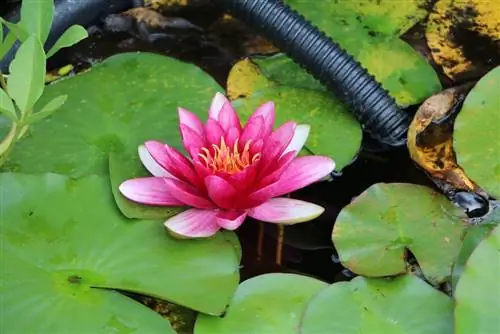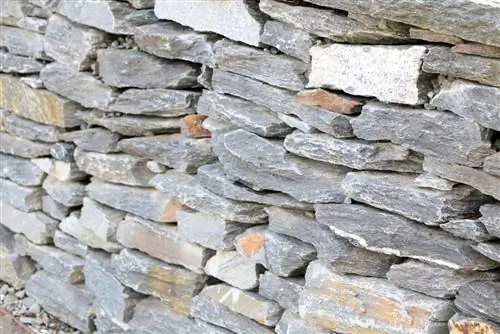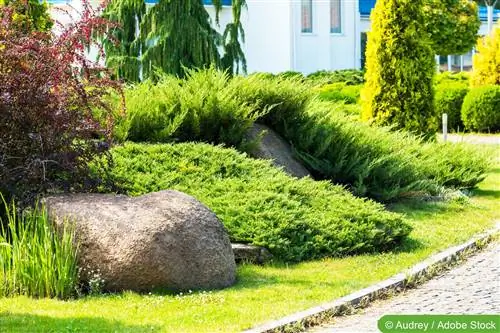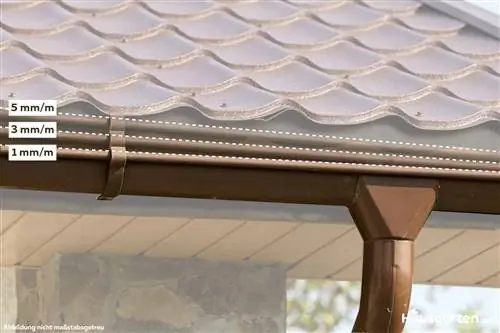- Author admin [email protected].
- Public 2023-12-17 03:39.
- Last modified 2025-01-24 12:45.
A magnificent rock garden on a hillside has several advantages. On the one hand, rock gardens are very suitable for such soil conditions, on the other hand, once they have been built, they are very easy to care for and are particularly beautiful to look at. They are considered absolute eye-catchers and quickly become the pride of every hobby gardener. They also provide an excellent contrast to a lawn or normal border beds. On a hillside it is also possible to stage many variations of a rock garden. Although rock gardens can also be created on a flat surface, they only get the real kick with a decorative wall and a brick seating area.
Rock garden design on a slope - rock garden on a slope
A rock garden on a slope is, for example, ideal for a small stream or a representative design with large boulders. Numerous plants from high- altitude regions are suitable for planting. An alpinarium is a special form of rock garden that consists of mountain plants that only occur in the Alps.
Locations for a hillside rock garden
Not every slope is suitable for a rock garden, as it only thrives in a sunny location. A partially shaded location is also acceptable if the planting is chosen accordingly. However, a slope in the shade is not suitable for creating a stone bed. The soil should be dry and permeable. Loamy soil is unsuitable for an alpinarium because it often creates waterlogging, which the sensitive mountain plants cannot tolerate at all. It is therefore advisable to lay a drainage system before creating the stone bed to ensure drainage. The future location should be cleared of all weeds and soil roots before planting. If a rabbit or chicken wire is also laid in the ground, this prevents infestation by voles or moles, which like to nest under stones. For drainage, a hand-width layer of pebbles or lime chippings is piled up at the level of the first row of stones. A water-permeable fleece on the pebbles prevents them from mixing with garden soil, which would block the drainage. This is followed by a slightly offset second drainage layer, which is, however, narrower than the first. If the soil is rich in nutrients, it must be mixed with sand or lime chippings, as mountain plants prefer poor soils.
Creating a stone bed
For experienced hobby gardeners, creating a rock garden is easy to do. However, if you are breaking new ground, you should seek advice from experts. A professional garden planner or a computer program may be able to help you plan the garden professionally. But many hobby gardeners have their own ideas that they can implement well. Nevertheless, all gardening enthusiasts should at least create a bed sketch with the details and a planting plan before planting, so that the right plants can be selected. As soon as the ground is equipped with drainage and possibly a wire to prevent rodent infestation, the rough preparations should be started, such as adding additional mounds of earth, watercourses or placing large stones or boulders. A watercourse in particular must be designed first because of the complicated system and possible electrical connections. This means that electrical cable connections can be laid or created without any problems. Stepping stones or open spaces with stone slabs should then be created. It is advisable to fill the cracks between the stones or grout them with filler. This way a sudden downpour doesn't undermine the stepping stones.
Planting a stone bed
If you choose your plants carefully in advance, you will have more fun with good plant growth and save yourself some unnecessary care. Selection should take into account light and soil conditions to achieve optimal growth. After all, no rock garden is effective if only stunted plants vegetate. A special form of rock garden is the Alpinarium, which is primarily filled with all types of high alpine plants. Evergreen dwarf trees are also often used here, as they are very attractive even in winter and only grow very slowly. Grasses, herbs, perennials or bulbous plants should also be included in the planting plan, such as thyme or lavender. Ground cover plants are important to maintain an attractive look all year round.
Selection of perennials
- Types of stone crushers
- Gentian
- Edelweiss
- Sun Beauty
- Carnation
- Cyclamen
- Primroses
- Cushion perennials
- Cat paws
- Dwarf bellflower
Selection of trees
- Dwarf Mountain Pines
- Nest Spruce
- Hanging willow
- creeping juniper
- Small gorse
Grasses
- Blue Diaper Grass
- Blue Bulrush
- Beargrass
- Bluegrass
Onion or tuberous plants
- Wild Tulips
- Crocuses
- low daffodils
- Bluestar
- Grape Hyacinths
Care
A planted rock garden requires less maintenance than normal gardens, which is ideal for hobby gardeners with little time. The weed infestation is usually kept to a minimum due to the gravel around the plants and the poor soil or is particularly easy to remove. Moss infestation is caused by excessive moisture and must be removed, although additional drainage should be considered. The rock garden hardly needs to be fertilized and pruning the plants is rarely worthwhile due to their very slow growth. However, washed out soil should be replaced. Watering is only necessary in particularly hot, dry summer months. However, care should be taken regularly to ensure that seeds from other plants cannot settle in the rock garden. Since the mountain plants grow very slowly, they are quickly defeated in the fight against other soil colonizers and are thus displaced. Slugs and similar pests must be rigorously removed. Mosses such as liverwort, which suffocate mountain plants, are similarly harmful. After removal, loosening the soil with sand or lime chippings helps against moss infestation.
Interesting facts
A rock garden is suitable for both large and small gardens. Hilly terrain looks particularly beautiful. Colorful upholstered perennials between small conifers and, of course, stones, that's how you imagine a rock garden. Of course, a pond can also be integrated. But it must be adapted to the size. The arrangement no longer seems too big. Paths are created in the rock garden from small stones, e.g. stone or gravel. Roots or other decorative objects add variety and add highlights.
In flat rock gardens, plant bowls can also be placed between the stones. Depending on the season, you can insert flowering plants between trees and grasses. Of course, stones are important for a rock garden.
Selection of stones
- Uneven ground is ideal.
- Natural effect is important.
- Soil as lean and dry as possible, install drainage if necessary.
- Mix heavy soils with sand.
- Place stones so that it looks natural (not in a row and in one direction)!
- Boulders, sandstones, but also slate and layered stones are well suited.
- Select only one rock type!
- Dig in large stones up to a third!
- A rock garden can also be created on a dry stone wall.
Pond or stream
- Sufficient space is important!
- If possible, use round stones for design.
- The pond should also look natural.
- It is better not to use plastic pools where the edges are visible at the end!
Plants
The rock garden stands or falls with the right plants. In general, “less is often more”. Don't choose too many different plants, rather use a few varieties over a large area. The same plants in different locations in the rock garden are also nice to look at. The important thing is that something is always blooming.
Dwarf trees
Alpine azalea, hanging willow, creeping juniper, Japanese maple, jackflower, gorse, five-finger bush, rock daphne, dwarf conifers, nest spruce, dwarf mountain pine
Perennials
Gentian, edelweiss, primroses, cyclamen, low sedum, sun roses, common thrush, alyssum, cat's paw, alpine aster, small bellflowers, alpine carnation, saxifrage species,
tuber plants
Tulips (ideally wild tulips), daffodils (low species), crocuses, snowdrops, winter aconites, squill, grape hyacinths, dwarf irises, autumn crocuses
Conclusion
A rock garden suits every house. An uneven surface is important; a slope is favorable. Upholstery perennials in particular fit well between the stones. When choosing, make sure that something is always blooming! The right soil is important for the good development of the plants. Some like lime, others don't. The rock garden must not be planted too sparsely! Lush upholstered perennials interspersed with small onion plants and one or two small trees placed around a small pond - that's pure harmony. Birds and other small animals also feel at home there.






